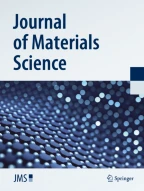279Accesses
91Citations
Abstract
The torsional stress-strain behaviour of isotropic poly(methylmethacrylate) (P M M A), poly(ethylene terephthalate) (P E T) and polyethylene has been studied under hydrostatic pressures up to 7 kbar. In P M M A the following important features were observed. First, there is a monotonic increase in the initial slope of the stress-strain curve with increasing pressure. Secondly, there is a substantial increase in the yield stress and the strain to yield as pressure is raised. Thirdly, there is a transition in the mode of failure at elevated pressure, the specimens fracturing in the high pressure region before a drop in stress occurs. Finally, in the high pressure region the fracture stress increases with increasing pressure but the strain at fracture decreases.
The observed yield behaviour can be represented formally in a number of ways, and the results will therefore be discussed accordingly, in an attempt to give a general yield criterion for P M M A. The fracture behaviour has been analysed in terms of the Griffith ideas for fracture of glassy materials, and this will also be discussed.
The results for poly(ethylene terephthalate) (Arnite) differ significantly from those for P M M A. Specimens of Arnite as received from the manufacturers were ductile in torsion at atmospheric pressure, and the torsional yield stress rose monotonically with increasing hydrostatic pressure. Annealing the specimens produced embrittlement at atmospheric pressure, but on testing under conditions where there is no tensile component of stress (i.e. at very low hydrostatic pressures) ductile behaviour was observed.
The contrast between P M M A and Arnite suggests that in the former case there aresurface flaws which are penetrated by the hydraulic fluid at high pressures, whereas in the latter caseinternal flaws are produced by annealing.
Polyethylene remained ductile over the complete pressure range, with a pressure dependence of the tensile yield stress which was similar to that shown by polyethylene terephthalate.
This is a preview of subscription content,log in via an institution to check access.
Access this article
Subscribe and save
- Get 10 units per month
- Download Article/Chapter or eBook
- 1 Unit = 1 Article or 1 Chapter
- Cancel anytime
Buy Now
Price includes VAT (Japan)
Instant access to the full article PDF.
Similar content being viewed by others
Explore related subjects
Discover the latest articles, news and stories from top researchers in related subjects.References
S. B. Ainbinder, M. G. Laka, andI. Yu. Maiors,Mekhanika Polimerov1 (1965) 65.
W. Whitney andR. D. Andrews,J. Polymer Sci.C16 (1967) 2981.
P. B. Bowden andJ. A. Jukes,J. Mater. Sci.3 (1968) 183.
K. D. Pae, D. R. Mears, andJ. A. Sauer,Polymer Lett.6 (1968) 773.
G. Biglione, E. Baer, andS. V. Radcliffe, Paper presented at Brighton Conference on Fracture (April, 1969).
K. D. Pae andD. R. Mears,J. Polymer Sci.B6 (1968) 269.
L. Holliday, J. Mann, G. Pogany, H. D. Pugh, andD. A. Green,Nature202 (1964) 381.
N. Brown andI. M. Ward,J. Polymer Sci.6 (1968) 607.
N. Brown, R. A. Duckett, andI. M. Ward,Phil. Mag.18 (1968) 483.
J. M. Stearne andI. M. Ward,J. Mater. Sci.4 (1969) 1088.
B. Crossland,Proc. IME168 (1954) 935.
C. M. Kaye, andJ. M. Roberts, Honours B.Sc. Report No. 68/46 (1968) Mechanical Engineering Dept, University of Bristol.
Th. Von Karman,Z. Ver. dtsch. Ing.55 (1911) 1749.
R. Boker, Dissertation, Tech. Hochschule zu Aachen, “The Mechanics of Plastic Deformation in Crystalline Bodies”.
P. W. Bridgman,J. Appl. Phys.18 (1947) 246; “Studies in Large Plastic Flow and Fracture with special emphasis on the effects of hydrostatic pressure” (McGraw-Hill, London and New York, 1952).
B. Crossland andW. H. Deardon,Proc. IME172 (1958) 805.
P. Beardmore,Phil. Mag, in press.
A. A. Griffith,Phil. Trans.221 (1921) 163.
J. J. Benbow andF. C. Roesler,Proc. Phys. Soc.B70 (1957) 201.
J. P. Berry, “Fracture Processes in Polymeric Solids” (Wiley, New York, 1964) pp. 195.
T. L. Smith,J. Polymer Sci.32 (1958) 99.
Author information
S. Rabinowitz
Present address: Metallurgy Department, Scientific Research Staff, Ford Motor Company, PO Box 2053, Dearborn, Michigan, USA
I. M. Ward
Present address: Department of Physics, University of Leeds, Leeds, England
Authors and Affiliations
H. H. Wills Physics Laboratory, University of Bristol, Bristol, UK
S. Rabinowitz & I. M. Ward
Department of Mechanical Engineering, University of Bristol, Bristol, UK
J. S. C. Parry
- S. Rabinowitz
You can also search for this author inPubMed Google Scholar
- I. M. Ward
You can also search for this author inPubMed Google Scholar
- J. S. C. Parry
You can also search for this author inPubMed Google Scholar
Additional information
1 bar=105 N/m−2
Rights and permissions
About this article
Cite this article
Rabinowitz, S., Ward, I.M. & Parry, J.S.C. The effect of hydrostatic pressure on the shear yield behaviour of polymers.J Mater Sci5, 29–39 (1970). https://doi.org/10.1007/PL00020253
Received:
Accepted:
Issue Date:
Share this article
Anyone you share the following link with will be able to read this content:
Sorry, a shareable link is not currently available for this article.
Provided by the Springer Nature SharedIt content-sharing initiative



